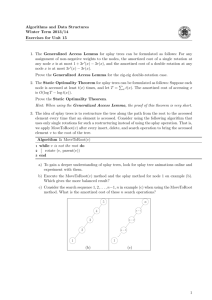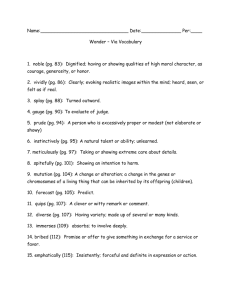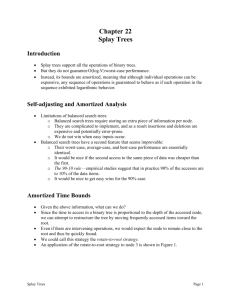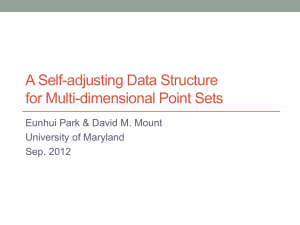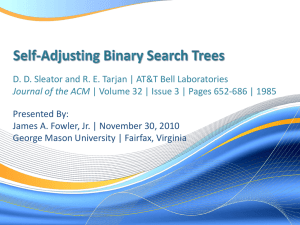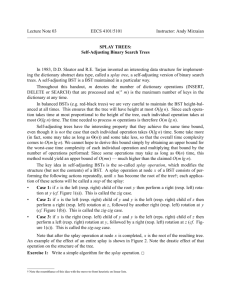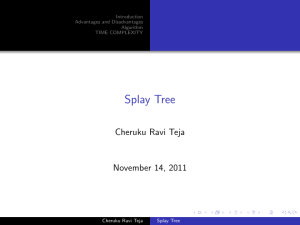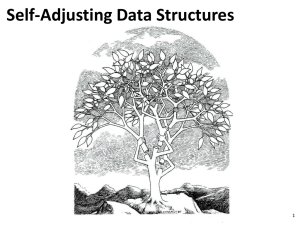COS 423 Splay Trees
advertisement
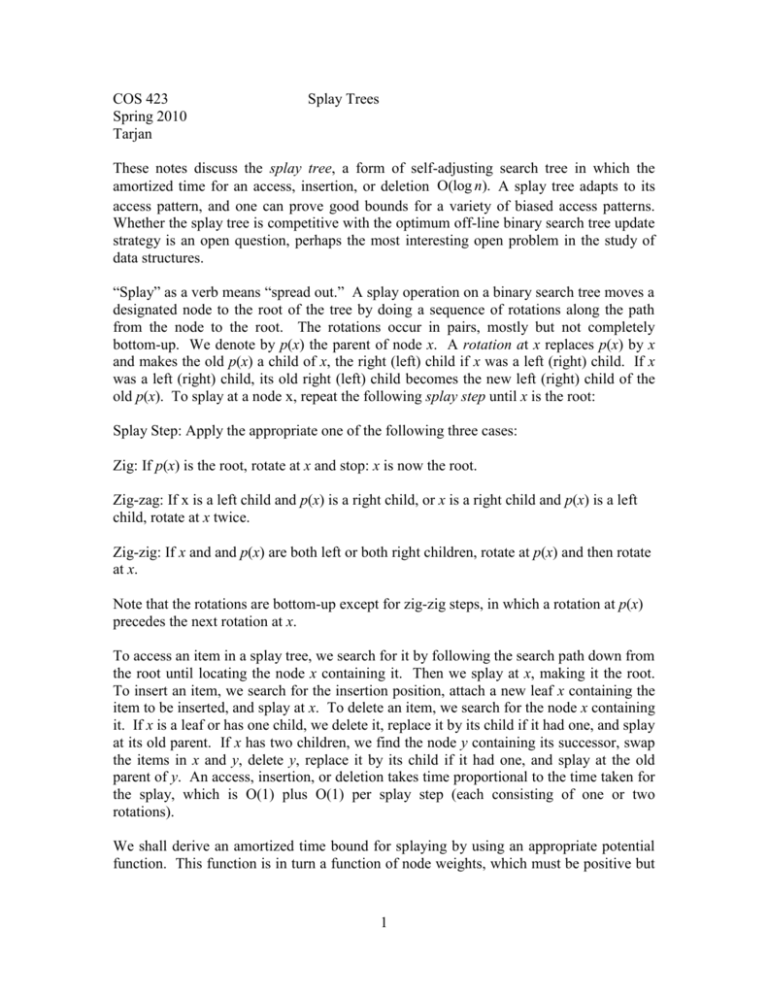
COS 423
Spring 2010
Tarjan
Splay Trees
These notes discuss the splay tree, a form of self-adjusting search tree in which the
amortized time for an access, insertion, or deletion O(log n). A splay tree adapts to its
access pattern, and one can prove good bounds for a variety of biased access patterns.
Whether the splay tree is competitive with the optimum off-line binary search tree update
strategy is an open question, perhaps the most interesting open problem in the study of
data structures.
“Splay” as a verb means “spread out.” A splay operation on a binary search tree moves a
designated node to the root of the tree by doing a sequence of rotations along the path
from the node to the root. The rotations occur in pairs, mostly but not completely
bottom-up. We denote by p(x) the parent of node x. A rotation at x replaces p(x) by x
and makes the old p(x) a child of x, the right (left) child if x was a left (right) child. If x
was a left (right) child, its old right (left) child becomes the new left (right) child of the
old p(x). To splay at a node x, repeat the following splay step until x is the root:
Splay Step: Apply the appropriate one of the following three cases:
Zig: If p(x) is the root, rotate at x and stop: x is now the root.
Zig-zag: If x is a left child and p(x) is a right child, or x is a right child and p(x) is a left
child, rotate at x twice.
Zig-zig: If x and and p(x) are both left or both right children, rotate at p(x) and then rotate
at x.
Note that the rotations are bottom-up except for zig-zig steps, in which a rotation at p(x)
precedes the next rotation at x.
To access an item in a splay tree, we search for it by following the search path down from
the root until locating the node x containing it. Then we splay at x, making it the root.
To insert an item, we search for the insertion position, attach a new leaf x containing the
item to be inserted, and splay at x. To delete an item, we search for the node x containing
it. If x is a leaf or has one child, we delete it, replace it by its child if it had one, and splay
at its old parent. If x has two children, we find the node y containing its successor, swap
the items in x and y, delete y, replace it by its child if it had one, and splay at the old
parent of y. An access, insertion, or deletion takes time proportional to the time taken for
the splay, which is O(1) plus O(1) per splay step (each consisting of one or two
rotations).
We shall derive an amortized time bound for splaying by using an appropriate potential
function. This function is in turn a function of node weights, which must be positive but
1
can otherwise be chosen arbitrarily. By choosing various sets of weights, we can obtain
various useful bounds.
Given a positive individual weight w(x) for each node x, we define the total weight t(x) of
node x to be the sum of the individual weights of all descendants of x, including x itself.
Whereas the individual eight of a node depends only on the node, its total weight depends
on the structure of the tree: splaying can change it. We define the potential of a node x to
be ( x) 1gt ( x), where 1g is the base-two logarithm. Finally, we define the potential of
the tree to be the sum of the potentials of its nodes.
As the most important special case, suppose all individual weights are one. Then each
node has a total weight between one (a leaf) and n (the root). The node potentials are
between zero and 1gn, and the tree potential is between zero and n1gn.
The potential of the initial (empty) tree is zero. As long as the individual weights are at
least one, the tree potential is non-negative, so the total amortized time of an arbitrary
sequence of intermixed accesses, insertions, and deletions is an upper bound on the total
actual time, as desired. If the initial tree is not empty or we choose weights that are less
than one, we must take into account in our analysis difference between the initial and
final potentials of the tree.
For a splay we charge one unit of time plus one per splay step. We shall show that the
amortized time of a splay step is at most 3( ( x) ( x)) if the step is a zig-zag or zig-zig,
at most 3( ( x) ( x)) 1 if the step is a zig. Here primed values are after the step,
unprimed values are before the step. If we sum these bounds over all the steps of a splay,
the sum telescopes. Since there is at most one zig step, we obtain a bound on the
amortized time of the entire splay of at most 3( ( x)) 2, where is the potential of
the root, which is unchanged by the splay (why?), and ( x) is the potential of x before the
splay. If W is the sum of all the node weights, this gives the following lemma:
Splay Lemma: The amortized time to splay at x is at most 31g(W w ( x)) 2.
Let us analyze the amortized time for each kind of splay step. We denote by y and z,
respectively, the parent and grandparent of x just before the step. The only nodes whose
potential changes as a result of the step are x, y, and z; the total weights of all other nodes
remain the same.
A
zig
is
the
simplest
to
analyze.
The
amortized
time
is
1 ( x) ( y ) ( x) ( y ) 1 ( y ) ( x), since ( x) ( y ) (why?). This is at most
1 ( x) ( x),
since ( y ) ( x) (why?), which in turn is at most
1 3( ( x) ( x)) (why?), as desired.
2
In both a zig-zig and a zig-zag, ( x) ( z ) (why?), so the amortized time of such a step
is 1 ( y ) ( z ) ( y ) ( x). These cases are the interesting ones: we must show that
the change in potential is enough to cover the actual time (one unit) required by the step.
For a zig-zag, t ( y ) t ( z ) t ( x), since after the step y and z have no common
descendants and all of their descendants are descendants of x.
Thus either
t ( y ) t ( x) / 2, implying ( y ) ( x) 1, or t ( z ) t ( x) / 2, implying ( z ) ( x) 1.
We conclude that ( y ) ( z ) 2 ( x) 1. Also ( y ) ( x). (Why?) It follows that the
amortized
time
of
the
step
is
at
most
than
1 2 ( x) 1 2 ( x) 2( ( x) ( x)) 3( ( x) ( x)), as desired.
For a zig-zig, t ( x) t ( z ) t ( x) (why?), implying ( x) ( z ) 2 ( x) 1, or equivalently
( z ) 2 ( x) 1 ( x). Also, ( y ) ( x) and ( y ) ( x). (Why?) It follows that the
amortized
time
of
the
step
is
at
most
1 ( x) 2 ( x) 1 ( x) ( x) ( x) 3( ( x) ( x)), as desired. The splay lemma
follows by summing over all the splay steps as discussed above.
Now we apply the splay lemma. As the simplest application, let all node weights be one.
Then the splay lemma gives an amortized time for a splay of O(log n). Thus the
amortized time for an access is O(log n). This is also true of a deletion: deleting a node
cannot increase the potential, and the subsequent splay takes O(log n) amortized time.
This is true of an insertion as well, but to show this we must bound by O(log n) the
potential increase caused by adding a leaf. The new leaf has potential zero. If the
ancestors of the new leaf are x1, x2 ,...., xk from bottom to top, then the potential increase
k
caused by the addition of the new leaf (before the splay) is
(lg(t ( x j ) 1) lg t ( x j )).
j 1
Since t ( x j 1) t ( x j ) 1, this sum is bounded by a telescoping sum and is at most
1g(t ( xk ) 1) 1gt ( x1 ) 1gn. We conclude that the amortized time of an insertion is
O(log n). Thus splay trees are as efficient in the amortized case as balanced search trees
are in the worst case, an efficiency they achieve without maintaining any explicit balance
information.
By choosing different weights, we can obtain several more-specialized results. To
simplify matters we shall henceforth assume that the set of items in the tree is fixed and
that only accesses occur, no insertions or deletions. Since the initial tree is not empty, we
must add the initial potential minus the final potential to the sum of amortized times to
obtain a bound on the sum of actual times.
Consider an arbitrary sequence of accesses. Let m be the total number of accesses, and
let f k be the number of times the item in node k is accessed. If we let wk f k , the splay
lemma gives an amortized time of O(log(m / f k )) to access the item in node k, and a total
3
m
time for all the accesses of O( { f k log(m / f k ) f k 0}). This is within a constant factor
k 1
of the total access time for any fixed search tree, including the optimum tree for the given
access frequencies. That is, on any sequence of accesses, splaying is competitive with
the use of the static search tree for the given access sequence, even though it does not
know the access sequence in advance and does not keep track of access frequencies.
Counting global access frequencies is only one way to measure bias in an access
sequence. We consider two other kinds of bias, locality in space and locality in time. To
show that splaying exploits spatial locality, assume that there are no insertions, only an
initial tree containing n nodes and an arbitrary sequence of accesses. Let the nodes be
numbered from 1 in symmetric order (so that the node containing the smallest item is
numbered 1, the second-smallest is numbered 2, and so on. Assign to node k a weight of
1/ k 2 . Then the total weight is O(1) (why?), and the splay lemma gives an amortized time
of O(log k 1) to access node k. To get a valid bound we must take into account the
difference in potential between the initial tree and the final tree. The potential of the tree
is non-positive and at least O(n lg n), so if we assign an amortized time of
O(log k (n / m) log n 1) to each access of node k, the sum of the amortized access times
is an upper bound on the sum of their actual times. This is a special case of what is called
the static finger theorem: for any fixed position, the amortized time to access a node d
away from the fixed position is O(log d ), if there are enough accesses. There is a
dynamic version of this theorem that shows that the amortized time for an access is
logarithmic in the number of items between the current access position and the previous
one, but proving such a result seems to require a MUCH more complicated analysis.
To show that splaying exploits locality in time, again assume that there are no insertions,
only accesses. Number the accesses from 1 to m. Let ik be the item accessed by access
k. Let d k , the distance of access k, be the number of different items accessed since the
previous access of item ik (including ik ), or since the beginning of the sequence if this is
the first access of ik . Assign the weights 1, 1/4, 1/9,…, 1/ n 2 to the items in order by
first access. After access k, shuffle the weights by giving weight 1 to item ik and giving
weight 1/ j 2 to the item that had weight ( j 1)2 , for j 2,... , where the weight of
ik just before the access is 1/ 2 . Such a shuffling cannot increase the tree potential,
since ik is in the root. The total weight is O(1). The initial weight assignment and the
shuffling guarantee that the weight of ik just before access k is at least 1/ d k2 (why?), so
the splay lemma gives an amortized time bound of O(log d k 1) for access k. The tree
potential is non-negative and at least O(n lg n), so accounting for the difference in
potential between the initial and final tree gives an amortized time of
O(log d k ( n / m) log n 1) for access k. This result is called the working set theorem.
4
Exploration: Extend the results of the last two paragraphs to apply to an intermixed
sequence of insertions and accesses starting from an empty tree.
5
